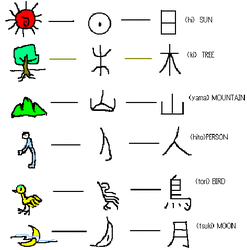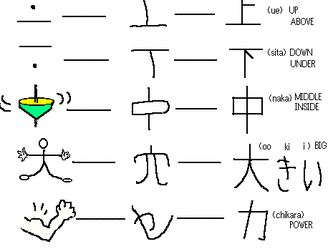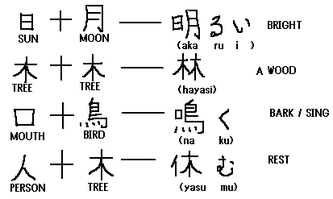漢字 Kanji

6世紀に日本に伝わったと言われる中国起源の文字で、中国本来の読み方からとった漢語と日本に既に存在していた言葉を漢字に当てはめた和語との双方に使われます。文字自体に意味がある表意文字で、そのほとんどが少なくとも2つの読み方を持ちます。字の成り立ちや用法により、6種類に分類されます。
象形文字:形をかたどったもの
指示文字:抽象的なものを表現
会意文字:2つ以上の文字を組み合わせ、意味を合成する
形成文字:2つの字を組み合わせ、一方が音を、他方が意味を表す
転注文字:その漢字本来の意味からほかの意味に転じたもの
仮借:漢字の意味に関係なく、音だけを他の意味に転注する
Kanji are said to be introduced to Japan from China sometime around the 6th century. When the Japanese adopted Kanji, they also adopted the Chinese way of reading them. At the same time, the Japanese gave the Chinese characters Japanese readings for existing Japanese words. They are ideographs representing objects or ideas. Most of Kanji have at least two different ways of reading. They are classified into six categories according to how they were formed or how they are used.
Shookei moji: Kanji developed from hieroglyphics
Shiji moji: Kanji expressing abstract objects
Kaii moji: Kanji representing an object or an idea by combining two or more characters
Keisei moji: Kanji formed by combining two characters, one representing the pronunciation and the other
representing the meaning
Tenchu moji: Kanji whose meaning has been changed from the original meaning
Kasha: Kanji representing an object or an idea regardless of its original meaning as it has the same sound as
the word
象形文字:形をかたどったもの
指示文字:抽象的なものを表現
会意文字:2つ以上の文字を組み合わせ、意味を合成する
形成文字:2つの字を組み合わせ、一方が音を、他方が意味を表す
転注文字:その漢字本来の意味からほかの意味に転じたもの
仮借:漢字の意味に関係なく、音だけを他の意味に転注する
Kanji are said to be introduced to Japan from China sometime around the 6th century. When the Japanese adopted Kanji, they also adopted the Chinese way of reading them. At the same time, the Japanese gave the Chinese characters Japanese readings for existing Japanese words. They are ideographs representing objects or ideas. Most of Kanji have at least two different ways of reading. They are classified into six categories according to how they were formed or how they are used.
Shookei moji: Kanji developed from hieroglyphics
Shiji moji: Kanji expressing abstract objects
Kaii moji: Kanji representing an object or an idea by combining two or more characters
Keisei moji: Kanji formed by combining two characters, one representing the pronunciation and the other
representing the meaning
Tenchu moji: Kanji whose meaning has been changed from the original meaning
Kasha: Kanji representing an object or an idea regardless of its original meaning as it has the same sound as
the word
Are you having hard time remembering the stroke order of Kanji? The general rule is to write from top to bottom, and left to right. Also, a horizontal line is usually drawn before a vertical one.
Use the tool below. Not only they will show you the stroke order of Kanji in a movie, they will pronounce different words using the Kanji you specified, and much more!
かんじアライブ
Kanji Alive
Use the tool below. Not only they will show you the stroke order of Kanji in a movie, they will pronounce different words using the Kanji you specified, and much more!
かんじアライブ
Kanji Alive



